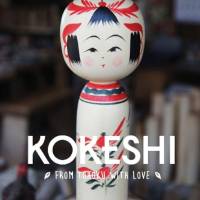Kokeshi dolls are a mainstay of tourists shop across Japan, yet many visitors to the country may not know that these simple handmade wooden dolls are, by and large, associated with Tohoku, the region in the northeast that was so devastated by the Great East Japan Earthquake, tsunami and nuclear disaster of March 11, 2011.
In "Kokeshi: From Tohoku With Love," author Manami Okazaki visits the region and interviews 20 koujin (kokeshi makers) who create these traditional dolls to discover the history and culture behind the various varieties of kokeshi (there are 11 aparently). The result is a delightful little book that captures the warmth of the artisans involved in creating the wooden dolls. "That moment you place the brush on a kokeshi your spirits lift. It is a strange and fascinating thing," says one. Some of the koujin Okazaki speaks with have been carving and painting kokeshi for more than 50 years and many are carrying on a family tradition that goes back generations. "I have been making kokeshi since 1945, I was 18 years old and it was the will of my parents," says another.
Throughout the book are photos of the people and places Okazaki visited, and as the dolls are also associated with the onsen (hot springs) areas of Tohoku, the book also includes a guide to the area. The photos of the matsuri (festivals) in the region are particularly fun.
Overall, the book reveals how deeply something as a basic as simple wooden doll can become so entrenched into a culture. Proceeds of the book will go toward Tohoku relief aid.



